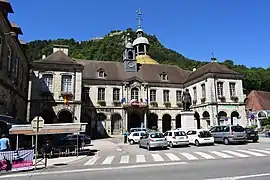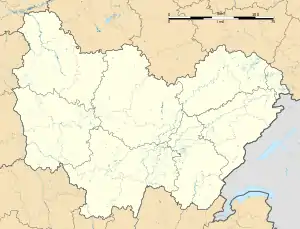Salins-les-Bains | |
|---|---|
 Salins-les-Bains Town Hall | |
 Flag  Coat of arms | |
Location of Salins-les-Bains | |
 Salins-les-Bains  Salins-les-Bains | |
| Coordinates: 46°56′31″N 5°52′45″E / 46.9419°N 5.8792°E | |
| Country | France |
| Region | Bourgogne-Franche-Comté |
| Department | Jura |
| Arrondissement | Dole |
| Canton | Arbois |
| Intercommunality | CC Arbois, Poligny, Salins – Cœur du Jura |
| Government | |
| • Mayor (2020–2026) | Michel Cêtre[1] |
| Area 1 | 24.68 km2 (9.53 sq mi) |
| Population | 2,471 |
| • Density | 100/km2 (260/sq mi) |
| Time zone | UTC+01:00 (CET) |
| • Summer (DST) | UTC+02:00 (CEST) |
| INSEE/Postal code | 39500 /39110 |
| Elevation | 284–737 m (932–2,418 ft) (avg. 350 m or 1,150 ft) |
| 1 French Land Register data, which excludes lakes, ponds, glaciers > 1 km2 (0.386 sq mi or 247 acres) and river estuaries. | |
Salins-les-Bains (French pronunciation: [salɛ̃ le bɛ̃]), commonly referred to simply as Salins, is a commune in the Jura department in the Bourgogne-Franche-Comté region in Eastern France.[3] It is located on the departmental border with Doubs, 34.8 km (21.6 mi) to the south-southwest of Besançon. In 2018, Salins-les-Bains had a population of 2,567.
The town owes its name to its saline waters which shaped its history for centuries; they continue to attract visitors today, for the town's bedrock contains salt and gypsum deposits. In 2009 the historic saltworks were added to the list of UNESCO World Heritage Sites as an addition to the Royal Saltworks at Arc-et-Senans site, which was inscribed in 1982.[4]
Geography
Salins is situated in the narrow Valley of the Furieuse, between two fortified hills, Fort Belin and Fort Saint-André, while to the north rises Mont Poupet (851 m or 2,791 ft).
History
Salins was an important city in Celtic times and became a Roman oppidum[5] known as Salinae Sequanorum.[6]
The territory of Salins, which was enfeoffed in the 10th century by the Abbey of Saint Maurice-en-Valais to the counts of Mâcon, remained in possession of their descendants till 1175. Maurette de Salins (1137-1200), heiress of this dynasty, brought the lordship to the house of Vienne, and her granddaughter sold it in 1225 to Duke Hugh IV of Burgundy, who ceded it in 1237 to John, Count of Chalon in exchange for the county of Chalon. John's heirs - counts and dukes of Burgundy, emperors and kings of the House of Austria - bore the title of sire de Salins (Lord of Salins).
In 1477 Salins was taken by the French and temporarily made the seat of the parlement of Franche-Comté by King Louis XI of France. The French re-took the town in 1668 and in 1674, and thenceforward it remained in their power. In 1825 the town was almost destroyed by fire. In 1871, it successfully resisted German troops in the Franco-Prussian War.
French composer Charles Galibert (1826–1858) was born in Salins-les-Bains.
Until the early-20th century, the slopes surrounding the town were largely covered in vines, which were however almost entirely abandoned after the phylloxera crisis of the mid-19th century decimated the vineyards. Little trace of this former activity remains today.
For much of the 20th century, the town was also famed for its potters, but today only three craftsmen continue to uphold this local tradition.
Great Saltworks
| UNESCO World Heritage Site | |
|---|---|
| Part of | From the Great Saltworks of Salins-les-Bains to the Royal Saltworks of Arc-et-Senans, the Production of Open-pan Salt |
| Criteria | Cultural: i, ii, iv |
| Reference | [https://whc.unesco.org/en/list/203bis-002 203bis-002 203bis-002] |
| Inscription | 1982 (6th Session) |
| Extensions | 2009 |
The extraction of salt at Salins-les-Bains began during the Middle Ages at the latest.[4] As early as 1115, there were two saltworks located at wells around the town, and because of the salt production, Salins-les-Bains was the largest town in Franche-Comté after Besançon in medieval times.[5] Deforestation in the region during the 17th and 18th centuries led to the creation of the Royal Saltworks at Arc-et-Senans, at a more favorable location near a large forest.[4][5] However, the brine extracted from Salins would still be used, being channeled to the Royal Saltworks, 21 km away, for processing.[5] In 1962, the Great Saltworks of Salins-les-Bains ceased all production.[4]
Demographics
|
| ||||||||||||||||||||||||||||||||||||||||||||||||||||||||||||||||||||||||||||||||||||||||||||||||||||||||||||||||||
| Source: EHESS[7] and INSEE (1968-2017)[8] | |||||||||||||||||||||||||||||||||||||||||||||||||||||||||||||||||||||||||||||||||||||||||||||||||||||||||||||||||||
Sights
The town has a Romanesque church, St-Anatoile, which has been well restored, and a hôtel de ville from the 18th century. A 17th-century Jesuit chapel contains a library, established in 1593, and a museum.
Transportation
Salins-les-Bains is on the Paris to Lausanne (Switzerland) road. The closest railway station is in Mouchard, a few kilometres away.
Twin towns
 Horb am Neckar, Germany, since 1991
Horb am Neckar, Germany, since 1991
See also
References
- This article incorporates text from a publication now in the public domain: Chisholm, Hugh, ed. (1911). "Salins". Encyclopædia Britannica. Vol. 24 (11th ed.). Cambridge University Press. p. 71.
- ↑ "Répertoire national des élus: les maires". data.gouv.fr, Plateforme ouverte des données publiques françaises (in French). 2 December 2020.
- ↑ "Populations légales 2021". The National Institute of Statistics and Economic Studies. 28 December 2023.
- ↑ INSEE commune file
- 1 2 3 4 "From the Great Saltworks of Salins-les-Bains to the Royal Saltworks of Arc-et-Senans, the Production of Open-pan Salt". UNESCO World Heritage Centre. United Nations Educational, Scientific, and Cultural Organization. Retrieved 11 October 2021.
- 1 2 3 4 "From the Great Saltworks of Salins-les-Bains to the Royal Saltworks of Arc-et-Senans, the Production of Open-pan Salt". World Heritage Site. International Council on Monuments and Sites. Retrieved 11 October 2021.
- ↑
Jahn, Albert (1874). "Provincia Maxima Sequanorum, numero IV: Politisch-Geographisches und Historisch-Topographisches über die Provinz mit Bezug auf Burgundien: Die Westhälfte der Provinz mit Besançon u. s. w. grösstentheils burgundionisch". Die Geschichte der Burgundionen und Burgundiens bis zum Ende der 1. Dynastie (in German). Vol. 2. Halle: Verlag der Buchhandlung des Waisenhauses. p. 360. Retrieved 27 November 2023.
Im westjurassischen Provinztheile lagen auch die alt berühmten Salinae Sequanrorum (Salins) [...].
- ↑ Des villages de Cassini aux communes d'aujourd'hui: Commune data sheet Salins-les-Bains, EHESS (in French).
- ↑ Population en historique depuis 1968, INSEE